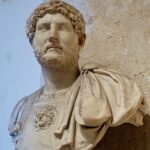A previously unknown structure was found in 2016 in the ruins of Hadrian’s Villa – a 1,900-year-old imperial complex that was twice the size of Pompeii. According to archaeologists, the structure is extremely richly decorated.
The building is covered with floor mosaics showing abstract paintings. The walls feature red and yellow wall panels separated by floral motifs. The ceiling, in turn, is covered with images of faces, gryphons and sphinxes. Naturally, after almost two thousand years, these works have survived only in parts and require renovation.
The building appears to be an apartment in a part of a complex. The question the scientists asked themselves was: who really lived in this exclusive mansion? After comparing the site with a similar structure in Ostia, it was finally concluded that the site was occupied by a high member of staff, not the emperor.
At this point, the greatest attention of scientists is attracted by the spectacularity of the building – beautiful statues and decorated halls. Hadrian’s Villa has been a source of knowledge and information about Hadrian’s life over the years. This emperor went down in history as a just and reasonable ruler (117-138 CE) who highly valued Greek culture – hence his nickname Graeculus.








